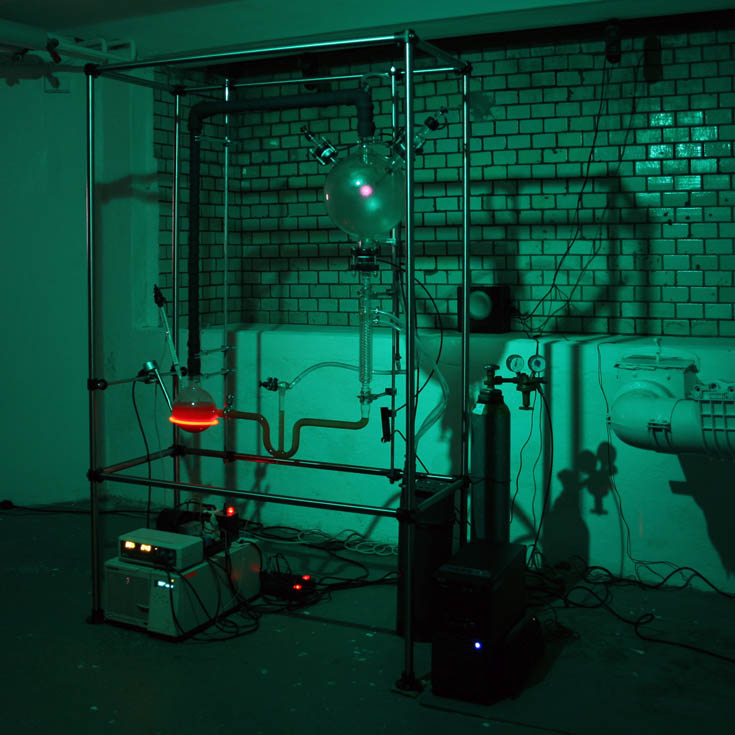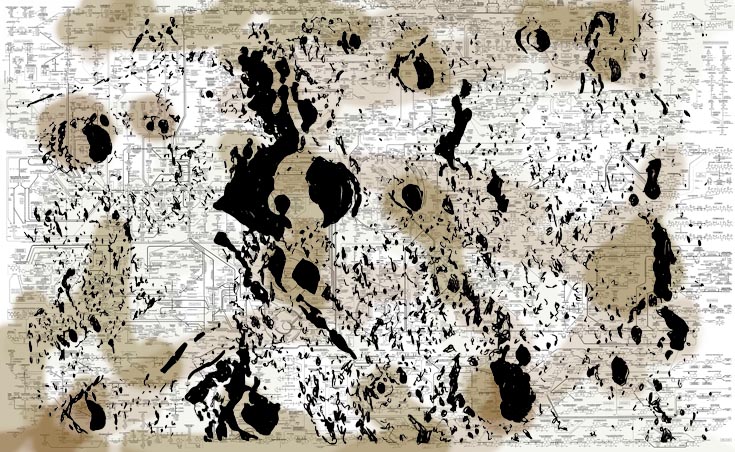Some velvet morning
Aus Daimon
(Weitergeleitet von Some velvet mourning)
Thomas Feuerstein, SOME VELVET MORNING, 2009. Glas, Edelstahl, div. Laborgeräte, 200 x 120 x 60 cm. Audioarchitektur: Szely, Software: Peter Chiochetti, Daniel Hekl, wissenschaftliche Beratung: Thomas Seppi
Courtesy Galerie 401contemporary, Berlin und Galerie Elisabeth & Klaus Thoman, Innsbruck
SOME VELVET MORNING ist Teil einer Werkgruppe, in der chemische Verbindungen, sprich „molekulare Skulpturen“ gebaut und in Flüssigkeiten und Destillaten gespeichert werden. Die Arbeit zitiert ein Experiment des Biochemikers Stanley Miller aus den 1950er Jahren, bei dem der Ursprung des Lebens als Wandlung anorganischer in organische Chemie untersucht wurde: Eine simulierte Ursuppe aus Wasser, Ammoniak, Methan, Wasserstoff und Kohlenstoffmonoxid wird erhitzt und in den aufsteigenden Dampf Energie in Form elektrischer Blitze eingebracht. Die daraus resultierenden Prozesse bilden essentielle Bestandteile des Lebens wie Aminosäuren, die von einem Chromatographen analysiert werden. Im Unterschied zur Laborpraxis werden die Daten nicht grafisch, sondern akustisch von einem Synthesizer interpretiert. Eine von Peter Szely entworfene Audioarchitektur generiert aus den Datenströmen Töne und transponiert die „molekularen Skulpturen“ in den Raum.
Wie Strukturen, Verbindungen und komplexe Formen entstehen, ist Gegenstand von Feuersteins DAIMONOLOGIE. Seit 2004 entwickelt er Projekte, in denen der Begriff DAIMON Aktualisierungen erfährt, die ihn über die traditionelle Dämonologie hinaus zu einem Schlüssel für Organisationsprozesse machen. SOME VELVET MORNING wirkt dämonisch, indem bestehende Ordnungen verändert und neue geformt werden. Die Installation weckt Assoziationen mit der Schaffung künstlichen Lebens und verweist auf Fragen nach der Entstehung und Speicherung von Information, Evolution und Emergenz.
SOME VELVET MORNING is a part of group of works, in which chemical compounds or “molecular sculptures“ are formed and then collected in the form of either a fluid of a distillate. This piece of work refers to an experiment done by the biochemist Stanley Miller in the 1950s in which he looked at the origin of life as a transformation from an inorganic to an organic chemical substance. A simulated primordial soup composed of water, methane, liquid
hydrogen and carbon monoxide is heated and the resulting steam is transformed into energy in the form of electrical sparks. The resulting process creates the basic ingredients for the life forms such as amino acids that are then analysed on a chromatogram. In contrast to a laboratory experiment the data is not
recorded graphically but acoustically using a synthesiser. An audio-architectural piece, designed by Peter Szely is generated from the tones that emerge and transformed into molecular structures in the space.
How structures, connections and complex forms come into being is the subject of Feuerstein’s DEMONOLGY. Since 2004 he has been working on projects in which the term DEMON is updated from its position in traditional demonology to that of a key to organisational processes.
SOME VELVET MORNING seems demonic in that established orders are changed and reformed. The installation awakens associations of the creation of artificial life forms and questions the origin and storage of information, evolution and emergence.
Thomas Feuerstein, PLANET PARADIES, 2009. Acryl auf C-Print und Aluminium, 110 x 180 cm.
Weblinks
Klangarchitektur von Peter Szely
Jeffrey L. Bada, Antonio Lazcano, Prebiotic Soup - Revisiting the Miller Experiment

